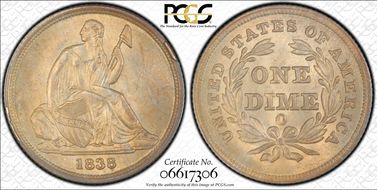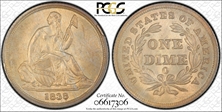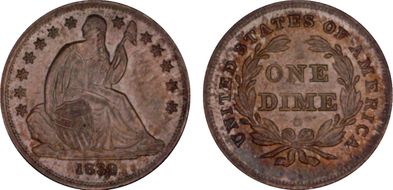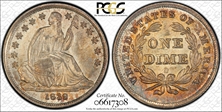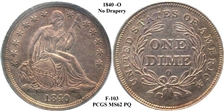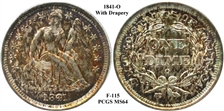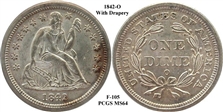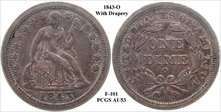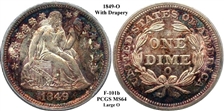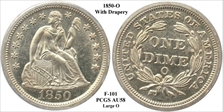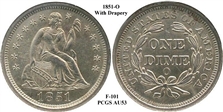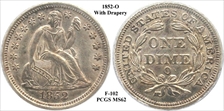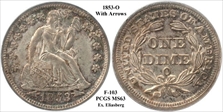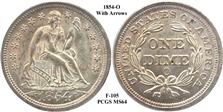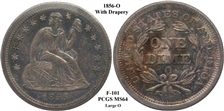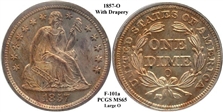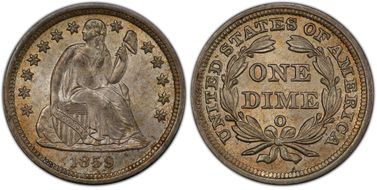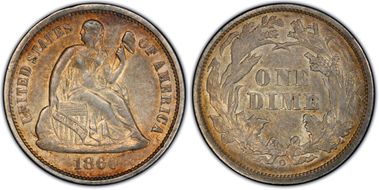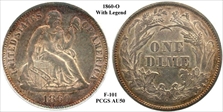Maine Collection of New Orleans Dimes 的钱币相册
Mintage: 489,064
Obverse Dies: 1 Known
There are two known die pairings for 1838 New Orleans coinage. Both die pairings employ the same obverse die. The initial 30 specimens of 1838-O dimes were struck on May 7-8, 1838. An additional 367,434 of Ahwash 1 were struck between June and July 1838. The final group (Ahwash 2) was struck in January 1839.
Plate Coin: Fortin 101, Ahwash 1, Repunched O/O, Consistent Medium Golden and Bronze Toning on Obverse and Reverse, Flawless Surfaces, Originally Holdered As ICG65, CoinFacts Plate Coin for 1838-O date.
Mintage: 489,064
Obverse Dies: 1 Known
There are two known die pairings for 1838 New Orleans coinage. Both die pairings employ the same obverse die. The initial 30 specimens of 1838-O dimes were struck on May 7-8, 1838. An additional 367,434 of Ahwash 1 were struck between June and July 1838. The final group (Ahwash 2) was struck in January 1839.
Plate Coin: Fortin 101, Ahwash 1, Repunched O/O, Consistent Medium Golden and Bronze Toning on Obverse and Reverse, Flawless Surfaces, Originally Holdered As ICG65, CoinFacts Plate Coin for 1838-O date.
Mintage: 1,323,000
Obverse Dies: 5 Known
A total of five different obverse dies and six reverse dies have been identified for 1839 New Orleans coinage. 1839-O dimes with a Small O mintmark are extremely rare in mint state. The plate coin was puchased at the Heritage pre ANA auction for an amount well above price guide values and is most likely the finest Small O 1839-O dime extant.
Plate Coin: Fortin 101, Small O, The Strike is Needle-Sharp, Every Aspect of Libertys Head, Stars, and all the Obverse Devices are Crisp and Pronounced. On the Reverse, Every Leaf, Letter, and Berry is Bold. Both Obverse and Reverse are Toned a Sunset-Gold at the Periphery, Lighter at the Centers.
Mintage: 1,323,000
Obverse Dies: 5 Known
A total of five different obverse dies and six reverse dies have been identified for 1839 New Orleans coinage. 1839-O dimes with a Small O mintmark are extremely rare in mint state. The plate coin was puchased at the Heritage pre ANA auction for an amount well above price guide values and is most likely the finest Small O 1839-O dime extant.
Plate Coin: Fortin 101, Small O, The Strike is Needle-Sharp, Every Aspect of Libertys Head, Stars, and all the Obverse Devices are Crisp and Pronounced. On the Reverse, Every Leaf, Letter, and Berry is Bold. Both Obverse and Reverse are Toned a Sunset-Gold at the Periphery, Lighter at the Centers.
Mintage: 1,175,500
Obverse Dies: 7 Known
Obverse 4 is one of 7 different 1840 New Orleans obverse dies. This obverse comes fairly well struck but is already showing signs of die erosion around the stars. Use the repunching on Stars 9 through 11 to identify this obverse die. The reverse is also well struck with a nicely centered Small O mintmark. To date, 5 Small O reverse dies have been identified. This reverse die has begun to show die erosion. Die cracks from the rim to ERIC in AMERICA are evident.
Plate Coin: Fortin-103, Ex. Lovejoy, Small O of 1839, Even Light Gold Toning, Very Rare Mintmark Variety
Mintage: 2,007,500
Obverse Dies: 10 Known
For 1841 New Orleans coinage, a total of ten different obverse dies and twelve reverses dies have been identified with multiple die pairings. The most significant varieties for 1841 New Orleans coinage are the Large O and Small O transitional Closed Bud reverses. Both Closed Bud reverse dies were left over reverse dies from 1840 and were paired with the same 1841 obverse die for production in early 1841 before additional reverse dies arrived from the mother mint in Philadelphia.
Plate Coin: Fortin 115, Small O, Well Struck With Light to Medium Rose, Gold and Orange Toning Throughout, Very Original
Mintage: 2,020,000
Obverse Dies: 4 Known
Four obverse dies and potentially five reverse dies have been identified for 1842 New Orleans coinage. The key diagnostic point for Obverse 4 is the die gouge to the left of Liberty's index finger. Tim Cook pointed out the possibility of using this die gouge as an attribution point around 1998. The date placement on Obverse 4 is very similar to Obverse 3, so the die gouge marker is very useful and recommended given the additional die states of this obverse die. Obverse 4 also exhibits a large die blob defect in the right field between Liberty's knee and Star 12. Reverse E features a Medium O mintmark that is positioned right and high. Faint die cracks are just beginning to emerge on the plate coin. I have seen another earlier die state example with no reverse cracks. Both the obverse and reverse are well struck during this die state, unfortunately this does not last long as the dies are polished and subsequently degrade.
Plate Coin: Fortin 105, Medium O, Even Silver Gray Obverse With Light Rose Reverse Toning, Second Finest Graded at PCGS, Well Struck for 1842 O Mint
Mintage: 150,000
Obverse Dies: 1 Known
A single die pair was employed for 1843 New Orleans coinage. A very scarce date to obtain in problem free VF or better grade with well struck and original 1843-O examples in EF or better proving to be rare. The 1843-O is a key date in AU or better and is extremely rare in Mint State grade.
The reverse die will show progressive die cracks at the 2nd T in STATES and the M in AMERICA to rim. Die rust is evident within the central portion of the wreath leaves and around the bow knot. 1843-O dimes have a Medium O mintmark which is positioned left and high.
Plate Coin: Fortin 101, Strictly Original Surfaces, Gun Metal Toning, Condition Rarity and Grade For 1843 New Orleans Dime
Mintage: 230,000
Obverse Dies: 1 Known
1845-O dimes are extremely rare in Mint State, with the Eliasberg 1845-O dime being the finest known. Several well struck AU coins have been offered at conventions and Internet auctions in the past several years. The current CoinValues pricing in AU50 through MS63 grades remains understated.
Plate Coin: Fortin 101, Pittman Pedigree, Well Struck Example in a Condition Census Grade, Beautiful Rose, Green and Blue Toning
Mintage: 300,000
Obverse Dies: 3 Known
In problem free EF or better, 1849-O dimes are difficult to locate. Mint State specimens are available but at a significant premium to later New Orleans Mint State dimes from 1850 through 1852. Large O examples are nearly always weakly struck on obverse and reverse. Finding a fully struck Large O dime will be very challenging and could take many years. Small O Varieties 102 and 104 are the most likely to be found well struck. Three obverse dies and two reverse dies were used to produce the 1849 New Orleans coinage.
Plate Coin: Fortin 101b, Large O Reverse With Die Cracks, Incredible Toning Throughout and a Bold Strike for Large O Coinage, Simply One of the Finest 1849-O Examples Seen
Mintage: 510,000
Obverse Dies: 4 Known
1850 New Orleans dimes are found with three mintmark sizes: Small, Medium and Large. Four obverse dies are paired with three Large O and one each Medium and Small O reverse dies. Mint State 1850-O dimes are considered R7 rarity regardless of mintmark size.
Plate Coin: Fortin 101, Fully struck and near continuous luster with few marks, a filler in PCGS registry set as primary example remains as NGC MS67 Star example.
Mintage: 400,000
Obverse Dies: 1 Known
A single die pair was employed to strike 1851 New Orleans coinage, though the obverse die appears to be polished down during its production life. In EF through AU grades, this date becomes very scarce. Only
a few example are known in Mint State. The obverse on all examples has weak drapery details between Liberty's body and right arm. This area has been polished down to a smooth appearance on the obverse die.
Plate Coin: Fortin 101, Well Struck From Single Die Pair In 1851, Even Light Gray Tone, the Obverse Die is Obviously Polished
Mintage: 430,000
Obverse Dies: 1 Known
A single 1852 obverse die is paired with two Large O reverse dies for New Orleans coinage. The two reverse dies are easy to distinguish. The first has a Large O mintmark that is well centered and high with no tilt. Examples for the second reverse die are much more difficult to locate. It has a Large O mint mark that is positioned right and tilts sharply left. 1852-O dimes are rare in Mint State grade.
Plate Coin: Fortin 102, Impressive Strike with Rose and Violet Toning Throughout
Mintage: 1,100,000
Obverse Dies: 4 Known
The 1853 New Orleans date is rarely found with full head detail and a strong strike. Of the four known obverse dies, dimes from Obverse 2 typically show full heads and strong dates even though this die does shatter with usage. Dimes from Obverse 1 are almost always seen with little or no head detail and haloing around the left stars. Obverses 3 and 4 exhibit weak dates.
The date and arrows placement on 1853 New Orleans dimes is consistent across all obverse dies as seen with the hubbed subset of 1853 With Arrows Philadelphia dies. At this point in time, it can be concluded that the date and arrows were placed into the hub die for New Orleans obverse dies. Interestingly, both reverse dies from 1852 are again used by the New Orleans mint to strike 1853 coinage.
Plate Coin: Fortin 103, Eliasberg Pedigree in OGH. Both Obverse and Reverse are Fully Struck for F-103 Variety Which is Extremely Difficult to Locate. Original Rose/Gold Toning Over Lustrous Surfaces. Many Years of Searching for a Fully Struck Mint State 1853-O Dime has Come to an End.
Mintage: 1,770,000
Obverse Dies: 10 Known
As with 1854 Philadelphia, on 1854 New Orleans coinage the date and arrows were placed on the master hub dimes resulting in a consistent placement of these devices on the obverse die. Variations in the strength of the date hubbing of the working dies produced strong and weak dates.
Plate Coin: Fortin 105, Die Crack Through 8 Digit In The Date, Very Well Struck With Even Luster Throughout, Light Gold/Brown Toning On Reverse
Mintage: 1,180,000
Obverse Dies: 6 Known
A better date in the Seated Dime series and challenging to locate in grades of EF or higher. The Large O has historically been more available than the Medium O, which is rare in EF or better. However a significant number of Medium O dimes have surfaced recently.
Six different obverse and reverse dies have been identified for 1856 New Orleans coinage.
Plate Coin: Fortin 101, Large O, Difficult Variety in Mint State, Incredible Original Toning, Satiny Luster, Predominantly Blue, Green Obverse Tone, Reddish Orange on the Reverse
Mintage: 1,540,000
Obverse Dies: 5 Known
1857 New Orleans coinage is found with Large and Medium reverses. The Medium O is moderately scarcer than the Large O in circulated grades and is very scarce in Mint State. The Large O is more available in Mint State.
Five obverse dies and six reverse dies have been identified for 1857 New Orleans coinage.
Plate Coin: Fortin 101a, A Sharp and Gorgeous Gem with Rich Underlying Lustre Supporting a Wealth of Peach, Gold, and Pale Rose Iridescence Tone.
Mintage: 40,000
Obverse Dies: 1 Known
The 1860 New Orleans date is scarce in the lower circulated grades and often comes porous due to examples being dug out of
the ground. Rare in problem free EF-AU and becomes extremely rare in Mint State. One of the key dates to the Liberty Seated Dime series.
Plate Coin: Fortin 101, Original brown and golden toning throughout with mark free field. Light wear and fully deserving of AU50 designation. A specimen that will not be upgraded in my lifetime.
Mintage: 40,000
Obverse Dies: 1 Known
The 1860 New Orleans date is scarce in the lower circulated grades and often comes porous due to examples being dug out of
the ground. Rare in problem free EF-AU and becomes extremely rare in Mint State. One of the key dates to the Liberty Seated Dime series.
Plate Coin: Fortin 101, Original brown and golden toning throughout with mark free field. Light wear and fully deserving of AU50 designation. A specimen that will not be upgraded in my lifetime.




















